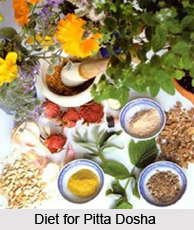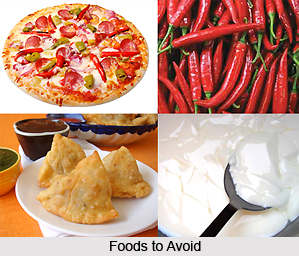 Pitta dosha is characterized by the elements like hot, sharp, light, sticky and oily. People with a pitta dosha are of medium build, with greater muscular development. They have soft and warm skin and also have a lot of body heat. They often perspire excessively. These kinds of people may experience premature graying of hair, baldness or excessive hair fall. Their skin has a tendency of developing acne, rashes, bruises or sunburn easily.
Pitta dosha is characterized by the elements like hot, sharp, light, sticky and oily. People with a pitta dosha are of medium build, with greater muscular development. They have soft and warm skin and also have a lot of body heat. They often perspire excessively. These kinds of people may experience premature graying of hair, baldness or excessive hair fall. Their skin has a tendency of developing acne, rashes, bruises or sunburn easily.
Thus, Ayurveda recommends that a person in whom the pitta dosha is dominant should consume those foods, which aggravates pitta. Such a person should take cool, dry, heavy, bitter or astringent food and also mildly natural sweet food is known to pacify pitta.
Foods to Include in Diet
There are various foods that can be included in the diet like milk, beans, and boiled vegetables. Mild spices like cumin, coriander and cilantro are also advantageous. Ghee, coconut oil, olive oil, cardamom, sprouts, coriander seeds and raw foods are very good for such person.
Such a person can eat most of the vegetables like asparagus, bell pepper, broccoli, brussel sprouts, cabbage, cauliflower, celery, corn, cucumber, lettuce, mushroom, peas, parsnip, potato, squash, and zucchini. Fruits like apples, banana, dates, coconut, grapes, lychee, mango, melons, and pomegranate can be eaten.
 Beverages like cool drinks, milk, water, coconut milk, fruit and vegetable juice can be consumed.
Beverages like cool drinks, milk, water, coconut milk, fruit and vegetable juice can be consumed.
Foods to Avoid
Spices, pungent and oily foods, mainly aggravate pitta dosha. Curry, fried foods and foods having strong odour like garlic and ginger also worsens the condition. Chillies are also known for increasing vata - pitta. Snacks, pickles and fermented food are also known for increasing pitta dosha. Grains like brown rice, millets, rye and corn also increases pitta dosha.
Such persons should not consume vegetables like beets, carrots, tomatoes, garlic, eggplant, onions and olives. Unripe and sour fruits should not be consumed by such person and mainly fruits like grapefruits, papayas, bananas, apricots berries, cherries, citrus fruits, cranberries, pineapple, plums rhubarb and peaches.
Junk food like pizza, burger, hot dog, roll, samosa, pastry and deep-fried snacks generally elevates pitta dosha. Smoking, drinking alcohol, tobacco and food items like vinegar, wafers, curds, corn, mustard and til oil are also known to aggravate pitta dosha.




















